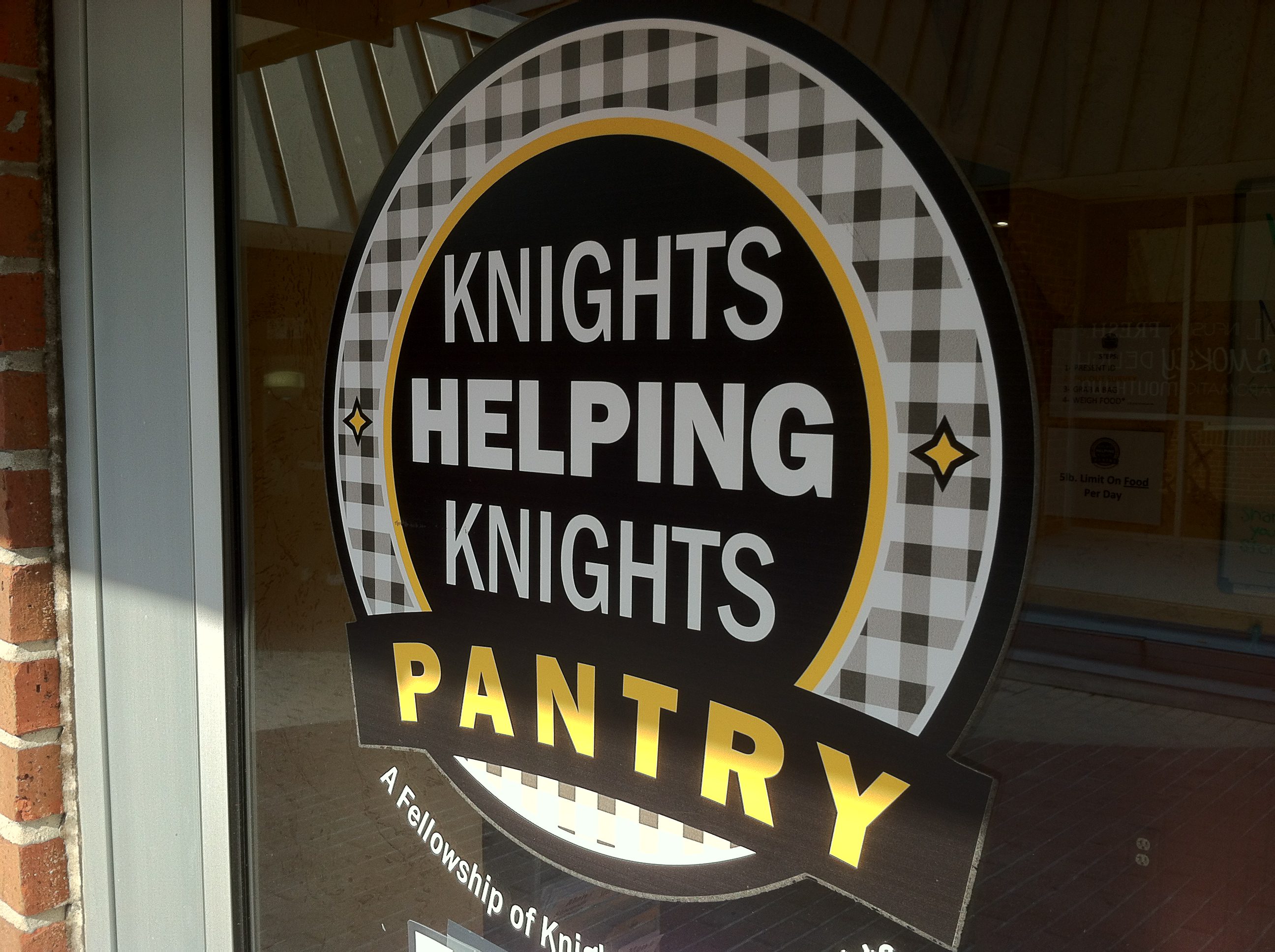by Paul Musgrave
A cluster of students and campaigners gather outside The Marketplace at Ferrell Commons, all donning yellow shirts and distributing fliers. It is an unusually warm day for March, with the spring sun shining high overhead as the clock ticks towards noon. As I approach the group, I am eagerly handed a Cortez/Rachel flier by a campaigner. “Remember to vote in the SGA elections tonight! Have some pizza while you’re here,” he says. Having skipped lunch on this unusually busy Wednesday, I accept his kind offer, but limited the chitchat; my reason for being at Ferrell Commons this morning isn’t for the SGA elections. Beyond the gauntlet of people lay a campaign of a different sort: the Knights Helping Knights Pantry. In stark contrast to the hustle and bustle of people in front of The Marketplace, the only indication that the Pantry is open for business is a small white and green sign in their window.

As I enter the Pantry, the smiling faces of two volunteers greet me. It is barely past twelve o’clock, and they already have their first visitor of the day. As the student quietly picks out items off the shelves, I am caught by the Pantry’s tidy appearance. Painted in the style of Old Europe with faux brick and stucco, it feels more like a fancy restaurant than a food pantry. The shelves are stocked with neatly organized cans and other non-perishable foods. On the back walls are toiletries and a rack of donated clothing, washed and dried by the Pantry’s volunteer staff.
“Students are allowed to take as many clothes and toiletries as they want,” says volunteer Jessica Siler. Food, however, is limited to five pounds per person, per day. This is done to help prevent a shortage in the Pantry’s donated stockpile.
After filling a grocery bag with edible goods like soups, veggies, boxes of pasta, and more, students bring their food over to the scales by the front window and write down how much they are taking that day.
“We’re not strict about the weight limit, though. It’s not a huge deal if a student has 5.3 pounds, or something like that,” says Ashley Kahan, the volunteer coordinator.
Throughout the morning, several students came by the Pantry to get food for the day. Six came in during the hour I was there. It all seemed so normal. With the exception that there was no exchange of money, you might think you were at a small grocery store. The student visitors were far removed from the stereotypical “hungry people” that are imagined as wearing tattered and dirty clothes and being poorly groomed. Indeed, the visitors at the Pantry seemed just like any other student one might pass in the Union, or just another one of your fellow classmates. Without being privy to the finer details of their lives, it is very easy to remain ignorant of the challenges they face as students and people.
“One student, a graduate student, once thanked us for saving his life. He was living in his car, showering at the gym and coming to us for food,” said Ashley, who recalled an experience from last semester. “Some students are asked if they would like to share their experiences on an anonymous basis. Some of them are really heartbreaking.” Understandably, most are not willing to publicly share how they deal with hunger and food insecurities. The Pantry’s website shares some testimonials from anonymous visitors, but even this section is rather scant. “This service to our university is so extremely invaluable for so many UCF students who are struggling. I cannot thank the Pantry enough for all they have helped me,” reads one anonymous testimonial on their website. Another reads: “This association is a blessing sent from God to all of us in need.” And another: “My undying thanks!” These are the words of students, ostensibly in just as normal a life situation as anybody else.
“It is incredible how at plain sight, there is no way of identifying these students,” says Willis Chico, the Pantry’s coordinator. “This is one of the biggest elements I have always credited with fueling ‘resistance’ from the public at large when it comes to program support. Since there is no real way of identifying students at plain sight, this ‘invisible’ epidemic continues to grow without the masses even knowing or realizing that this problem exists.”
Despite this resistance, the numbers alone speak volumes as to how much the Pantry has helped students at UCF. Between the start of the spring semester and the end of March, the Pantry has had 2,220 visitors. It has provided 7,727 pounds – that’s three and a half metric tons – of food to students at UCF. All of this was made possible by 623 volunteer hours and 5,901 pounds of donated food.
A National Illness
The problem of hunger and homelessness in college is bigger than UCF and the Knights Pantry. When the economy collapsed in 2008, it was devastating for many middle-class families who had enjoyed a long period of relative prosperity. When the housing bubble burst, a tsunami of property foreclosures pushed many families out of their homes, destroying their credit. The economic meltdown only worsened the situation with a sharp rise in unemployment. Placed in such a precarious situation, some families had no other way to support their college-aged children financially.
Two years ago, NPR ran a story about homeless students at UCLA in California. One student, Diego Sepulveda, was thrown into this terrible situation when he lost his job as the economy worsened. Although Diego’s blue-collar, hard-working family continued to be a moral support in his life, they simply did not have enough money to help support him financially.
This lack of financial support from families was only part of the problem for students going at it alone. The economic collapse caused even part-time and lower-paying jobs –- the ones that college students seek while in school –- to be in high demand as career men and women became more and more desperate for work. There simply were no jobs for Diego to jump right into after losing his job at Subway. With every dime to his name going to pay for his education, there was little money left for rent or food. Homeless, he would sleep on sofas in the library, at a friend’s house, or at the Student Activities Center where he could shower.
Joel John Roberts, CEO of People Assisting the Homeless, wrote in an article in The Huffington Post in December of last year that nearly 300 students are homeless at a Los Angeles community college, according to one school administrator. Another story that Roberts recalls is of a father and son living together under a bridge in downtown Los Angeles – the son was a student at a community college, trying to make it work. Sadly, it may be a futile endeavor on his part. According to the National Law Center on Homelessness and Poverty, nearly 50% of the homeless population drops out of school before finishing their education.
Turning a Blind Eye
In most situations, it is easy to forget about hungry and homeless people, or even simply ignore the realities of it. For instance, many are unaware that one in five children in the United States experience food insecurity. Perhaps it’s because our view of the hungry and homeless is so often clouded by stereotypes and misconceptions that the real truth tends to fall through the cracks.
Some may feel a brief, tingling burst of altruism when they roll down their car window at the stoplight and toss some change toward the homeless man on the street corner. Others in the same situation may simply look away, pretending to have not noticed the homeless man, as they wait impatiently for the light to turn green. Either way, whether they give or ignore, that person evaporates from the driver’s life once the light turns green, fading into just another statistic. Perhaps it’s because his long, scraggly beard evokes the stereotype of a drunken bum, the kind that has so often been ostracized in mainstream society. Maybe people worry that the money the homeless man receives will wind up in the cash register at a liquor store before it ever buys him a nourishing meal. Whatever excuse people use to comfort themselves, it is still a perfect representation of the complacent ignorance, existent among many, which continues to shroud the problem from view.
Before I sound too preachy, I have to confess that I have done the same thing at a stoplight. In fact, it happened just last week when I passed a buck to a man standing on the corner of Semoran and Colonial. It’s easier to just toss some change when the person is on the other side of the glass and you have no connection to him or her. It’s just a coincidence, courtesy of the highway system, that your two paths ever crossed.
It’s far harder, however, to make such a distinction when it is our friends and classmates who are in this terrible situation. While most students enjoy the relative comfort and security that has come to define college life – well, the security anyway – others among us are going it alone. All the stereotypes that exist when you see a homeless man on the street corner are suddenly thrown out the window when the scraggly beard is replaced with a neat and stylish haircut, or when the tattered clothes are replaced with ones you would wear. These aren’t drug addicts or alcoholics. These aren’t people who are lazy and unmotivated. These are our fellow students.
A Beacon of Hope
The Knights Helping Knights Pantry is what separates UCF from most other schools facing this epidemic of hunger and homelessness. As dramatic and serious as this problem may be, though, the Pantry is an uplifting and happy place. The volunteers are most welcoming for the Pantry’s visitors. A white board behind the counter tells of the Pantry’s statistics, surrounded with fun things such as a food-related “Word of the Day” and recipes for basic but tasty meals. Perhaps above all, the Pantry offers hope for those facing this leviathan issue of hunger and homelessness.
“My favorite reaction is when students come in and ask: ‘It’s free? Really?’” says Ashley with a laugh. “It’s always such an uplifting reaction from students.”
“It’s been an awesome experience working here,” says Jordan Carlson, another volunteer at the Pantry.
Despite this, the Pantry does face some serious obstacles. In addition to a general lack of awareness by the student body at large, the University does not support the Pantry financially due to insurance reasons. Although trusts have been set up with SGA and the UCF Foundation for the Pantry to purchase from the Second Harvest Food Bank if supplies run low, the Pantry relies on donations from others to operate. Fifteen donation spots are set up across campus where students can drop off canned foods, nonperishable foods, toiletries, school supplies, clothing and shoes to supply the Pantry. In addition, people can make monetary donations on the Pantry’s website at http://knightspantry.org/donate.
“Luckily, there’s been no shortage of food so far,” Jordan explains. “Nevertheless, donations are always needed.”
It’s hard to imagine how close this problem could be to many students at UCF. Unfortunately, college does not immunize people against problems such as food insecurity and homelessness. These are very real issues that affect real people. It may be easy to pass it off as irrelevant – something that doesn’t affect you and is most likely caused by their shortcomings. No matter what you think, this is a problem that does affect you, and me, and every single Knight you may walk past at the Student Union, or in the Library, or on Apollo Circle. At the end of the day, we are all Knights. And thanks to the hard work of the food pantry at Ferrell Commons, we are “Knights Helping Knights.”




